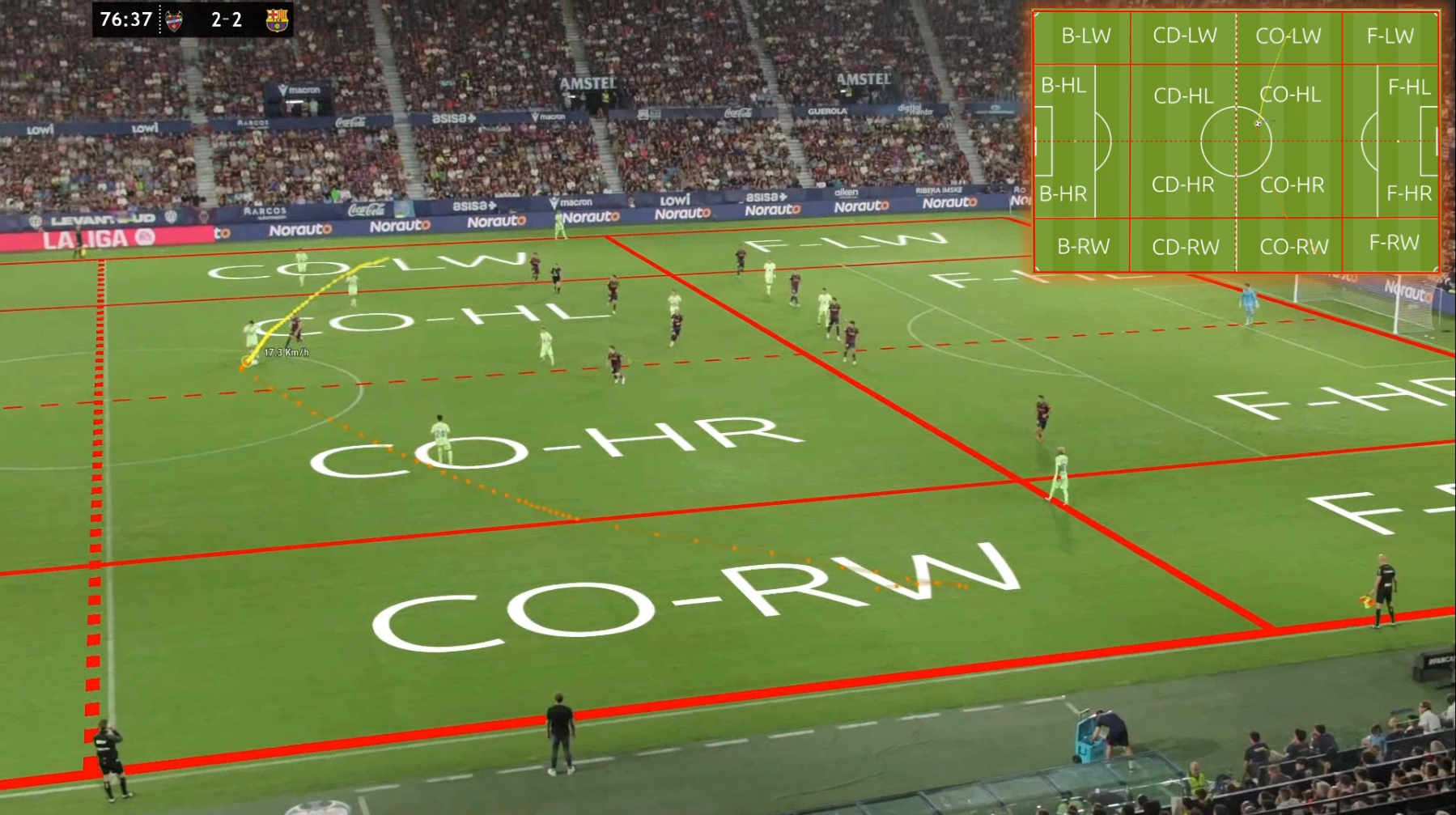
12 Sep “The Ball Has a Life of Its Own: Rethinking Possession in Football”
A coach’s dilemma
Every week, coaches and analysts ask themselves the same question: How does my team really build its attacks?
We often measure possession in percentages or completed passes, but these numbers don’t explain how a team progresses. Did they circulate endlessly in their own half? Did they accelerate through the half-spaces? Did they rely on wide overloads or direct verticality?
At the Football Intelligence & Performance Department at LALIGA, we decided to flip the perspective: instead of tracking players, we tracked the ball itself — its location, its speed, and the sequence of zones it travels through.
The result is a new way of seeing possession, one that reveals the life of the ball as the true fingerprint of a team’s offensive identity.
Defining the Zones: Why 16 and Not 9?
Most tactical analysis divides the pitch into thirds (build-up, construction, finalization) and lanes (left, central, right). We started from this logic but refined it to better capture the realities of modern play.
Our model uses 16 zones, created by crossing four horizontal phases with four vertical lanes:
Horizontal Phases (Depth):
- B (Build-up) – deepest area, ball circulation close to own goal.
- CD (Construction – Defensive half) – advancing through own half, often under pressure.
- CO (Construction – Offensive half) – opponent’s half, connecting midfield with attack.
- F (Finalization) – areas closest to the rival box.
Vertical Lanes (Width):
- LW (Left Wing)
- HL (Half-space Left)
- HR (Half-space Right)
- RW (Right Wing)
Together, these create the zone labels:
- B-LW, B-HL, B-HR, B-RW
- CD-LW, CD-HL, CD-HR, CD-RW
- CO-LW, CO-HL, CO-HR, CO-RW
- F-LW, F-HL, F-HR, F-RW
This grid offers both clarity (easy to use, easy to teach) and precision (capturing the crucial role of half-spaces).
The Method: Tracking the Ball’s Life
Instead of coding player positions or roles, we measured three ball-centered metrics:
- Time in zone – how long the ball stays in each defined sector.
- Average speed – the tempo of circulation within that zone.
- Zone sequences – the chain of transitions between zones that make up an offensive possession.
The focus is not who has the ball, but what the ball does. By mapping its trajectory, we can reconstruct a team’s attacking DNA.
What the Data Revealed
The analysis across multiple matches highlighted some striking patterns:
- Teams differ not only in possession percentage but in possession geography. Some spend extended time in CD-HL (deep half-spaces) before breaking lines, while others bypass these areas with direct verticality into CO or F.
- Tempo is decisive. Teams circulating slowly in deep build-up zones are more exposed to pressing traps, whereas quick circulation in offensive zones correlates with higher shot creation.
- Half-spaces matter. Many successful progressions involve transitions through CO-HL or CO-HR, confirming modern tactical emphasis on these corridors.
- Offensive fingerprints emerge. By sequencing zones, we can visualize whether a team’s preferred path is, for example, B-HR → CD-HR → CO-HR → F-RW (direct flank progression) or B-HL → CD-HL → CO-HR → F-HR (half-space switching).
Why This Matters for Practitioners
For coaches and analysts, this research translates into actionable insights:
- Session design: Training can simulate the “bottlenecks” where a team loses rhythm — e.g., accelerating play in CD-HL or stabilizing circulation in CO-RW.
- Opponent scouting: By mapping a rival’s offensive sequences, analysts can anticipate where pressure is most effective.
- Performance evaluation: Beyond possession %, coaches can now ask: Where did our possession take place? How quickly did it move? Did it follow our intended attacking routes?
Situating Our Findings in Football Science
Previous research has already suggested that possession is most effective when circulation is fast and vertically progressive. Other studies have shown that attacks developing through half-spaces increase the probability of shot creation compared to wide-only attacks.
Our contribution is to provide a ball-centric methodology that quantifies these insights with precision. Instead of abstract ideas about “verticality” or “tempo,” we can now measure them zone by zone, sequence by sequence.
Conclusion: A Call to Disciplined Curiosity
Football thrives on tradition and intuition, but progress comes when those intuitions are tested. This research challenges the assumption that possession is about quantity (time, passes) and reframes it around quality (zone, speed, sequence).
As coaches, analysts and performance staff, the invitation is clear:
- Treat the pitch as a laboratory.
- Track not only your players, but the life of the ball.
- Use evidence to validate or question your tactical beliefs.
Because in the end, the ball always tells the truth.


